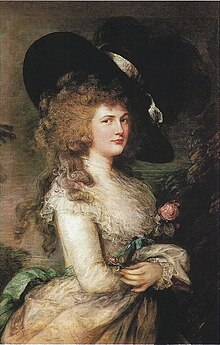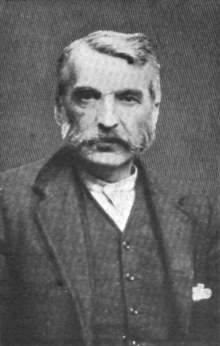Adam Worth
Adam Worth (* 1844 in the Kingdom of Prussia ; † January 8, 1902 ) was a German-American criminal. The Scotland Yard -Polizist Robert Anderson described him as " Napoleon of the criminal world."
It is believed that Arthur Conan Doyle Worth took as the model for Sherlock Holmes ' adversary Professor Moriarty , whom Conan Doyle calls the "Napoleon of Crime".
Life
Childhood and youth
Worth was born into a poor Jewish family in the Kingdom of Prussia . An original family name could have been "Werth". When he was five, his family emigrated to Cambridge , Massachusetts , USA , where his father worked as a tailor . In 1854 he left home and moved first to Boston and in 1860 to New York ; there he worked for a month as an employee in a department store.
When the Civil War broke out, Worth was 17 but enrolled in the Northern Army under the wrong age . Worth served in the 2nd New York Heavy Artillery , Battery L (later run under 34th New York Battery ) and was promoted to sergeant . In the Second Battle of Bull Run on August 30, 1862 he was wounded and came to the Georgetown Hospital in Washington, DC found out when he in the hospital that he and liked was reported, he left the hospital.
Criminal career
Worth became a "cash hunter", he enrolled under a false name in various regiments and deserted immediately after receiving the first cash. When the Pinkerton Agency found him, like many other hand money hunters, he left New York and went to Portsmouth .
After the war he was a pickpocket in New York . Little by little he built up a gang of pickpockets, with whom he then carried out major robberies. He was caught stealing a cashbox from an Adams Express Company train and sentenced to three years in prison. However, he was able to flee the Sing-Sing Detention Center after just a few weeks and resumed his criminal activities.
Worth began to work for the well-known fence woman Fredericka "Marm" Mandelbaum. With their help, he expanded his activities to bank robberies and business robberies and planned his own raids. In 1869 he helped Mandelbaum to free the safe cracker Charley Bullard through a tunnel from the White Plains Jail .
With Bullard, Worth then robbed the safe of the Boylston National Bank in Boston on November 20, 1869 . To do this, they dug a tunnel from one of the bank's shops. The bank hired the Pinkerton agency to track the delivery of the suitcases with the loot from Boston to New York. Worth and Bullard then fled to Europe .
Activities in Europe
Bullard and Worth first went to Liverpool . Bullard posed as the Texan oil magnate "Charles H. Wells", Worth as financier "Henry Judson Raymond". These names were both used for several years. The two hooked up with the barmaid Kitty Flynn, who later learned their real identities. She became Bullard's wife, but she wasn't averse to Worth either. Flynn gave birth to a daughter, Lucy Adeleine, in October 1870, and another daughter, Katherine Louise, seven years later. The paternity of the two children is controversial; it is conceivable that Flynn himself could not say exactly. In any case, Bullard and Worth both claimed paternity for themselves.
While the Bullards were on their honeymoon , Worth raided several pawn shops . He later shared the booty with Flynn and Bullard, and the three moved to Paris in 1871 .
In Paris, the police were still in disarray after the events of the Paris Commune . Worth and his allies opened an "American Bar", a restaurant and bar on the ground floor and an arcade on the first floor. Since gambling was illegal, the tables could be folded into the walls and floor. A bell could be rang from below to warn the guests in the event of a raid . Worth expanded his gang, including some old comrades from New York.
When Allan Pinkerton , founder of the Pinkerton Agency, visited the bar in 1873, Worth recognized him. Police carried out several raids on the bar, so Worth and the Bullards decided to leave. Worth used the bar one last time to defraud a diamond dealer, after which the three moved to London .
London Syndicate
In England , Worth and his companions bought Western Lodge in the Clapham Commons . He also rented an apartment in Mayfair and got access to high society. He built up a criminal network and organized major robberies and break-ins through several liaison officers. Whoever worked for him never found out his name. He insisted that no violence was used in the raids.
Gradually, Scotland Yard tracked him down, but couldn't prove anything. Inspector John Shore made the capture of Worth his personal goal.
Worth's problems with his organization began when he sent his brother John to Paris to cash a counterfeit check. John was caught and extradited to England. Worth managed to relieve his brother and bring him back to the United States. Four of his followers were caught in Istanbul while distributing more forged letters of credit. Worth had to spend a considerable amount of money bribing the judges and the police. Additionally, Bullard became more and more violent and turned into an alcoholic ; later he left London for New York, his wife Kitty followed him a short time later.

1876 steel Worth personally with the help of two ally the portrait of Georgiana Cavendish, Duchess of Devonshire by Thomas Gainsborough from the London gallery Agnew & Sons . He took the painting and did not try to sell it. The two men who had helped him, Junka Phillips and Little Joe, grew increasingly impatient. Phillips tried to get him to talk about the theft in front of plainclothes cops, but Worth fired him. Worth gave Little Joe money so that he could go back to the USA. There he attacked the Union Trust Company , was caught and confessed to the Pinkerton Agency. Scotland Yard was informed but there was still no clear evidence of Worth.
Worth kept the painting with him even when he was traveling when he was organizing new scams and robberies. Eventually he decided to travel to South Africa , where he stole $ 500,000 in rough diamonds. Back in London, he founded Wynert & Company to sell the diamonds below market value.
He married Louise Margaret Boljahn in the 1880s, still using the name Henry Raymond. The couple had two children, a son named Henry and a daughter named Beatrice. His wife probably didn't know his real name.
He finally smuggled the painting into the United States, where he deposited it.
Failure and arrest
In 1892 Worth visited Belgium, where Bullard was now in prison. He had worked with Maximillian Schönbein , Worth's competitor, and was arrested by the Belgian police together with him. When he arrived in Belgium, however, Worth learned that Bullard had recently passed away.
On October 5th, Worth improvised a robbery on a money transporter in Liège , together with two inexperienced helpers, one of them the American Johnny Curtin. The robbery went wrong, his helpers escaped, but Worth was arrested.
In jail, Worth refused to give his name and identify himself. The Belgian police then investigated and were able to identify him with the help of the New York Police Department and Scotland Yard. Schönbein, who was also in custody in Belgium, told the police everything he knew about Worth. While in prison, Worth heard nothing from his family in London, he did receive a letter from Kitty, who offered to pay for his defense.
The trial took place on March 20, 1893. Worth simply denied involvement in other crimes. The attack in Belgium was just a stupid idea out of financial difficulties. All other allegations are only hearsay and rumors. He said his fortune came from legal gambling. Worth was eventually sentenced to seven years in prison, which he served in Leuven .
During his first year in prison, he was beaten up by fellow inmates who were paid for by Schönbein. Worth later learned that Johnny Curtin, who was supposed to look after his wife in London, seduced her and then left her. His wife then collapsed and was admitted to a mental hospital. Worth's children were in the care of his brother John in the United States.
Discharge and death
Worth was fired in 1897 for good conduct. He returned to London and stole 4,000 pounds there. When he visited his wife, she hardly recognized him. He traveled to New York to visit his children. He then met with William Pinkerton , to whom he explained his life story in detail. Pinkerton's transcript is still in the archives of the Pinkerton Detective Agency in Van Nuys , California .
With Pinkerton's help, Worth arranged for the Duchess of Devonshire painting to be returned to Agnew & Sons for $ 25,000. The exchange took place in Chicago on March 28, 1901. Worth returned to London and lived there the rest of his life with his children. His son accepted an offer from the Pinkerton Agency and became an investigator there.
Adam Worth died on January 8, 1902. He was buried in Highgate Cemetery in a poor grave under the name Henry J. Raymond . In 1997 a small headstone was erected by the Jewish American Society for Historic Preservation .
In popular culture
Michael Caine played Adam Worth in the movie And Tomorrow A Thing Will Be Made . Worth is correctly portrayed as a criminal organizer, but the story is fictitious.
In the third season of the series Sanctuary - Guardians of the Creatures , Worth appears as an opponent. It has an evil, second personality that he claims is the basis for The Curious Case of Dr. Jekyll and Mr. Hyde . Except for the name, the Worth of the series has nothing in common with the real Worth. In the series, it's a mad Irish scientist who is into time travel and tries to destroy London and then the entire world.
Worth is also part of a storyline in Criminal Minds in which his name is used as an alias for a stalker who has a penchant for the works of Arthur Conan Doyle.
Individual evidence
- ^ A b c Ben Macintyre: The Napoleon of Crime: The Life and Times of Adam Worth, Master Thief. 1997
- ^ Jewish Amer. Society for Historic Preservation. Retrieved September 3, 2011
literature
- The American Magazine: American Illustrated Magazine. Colver Publishing House, New York 1905.
- Ben Macintyre : The Napoleon of Crime: The Life and Times of Adam Worth, Master Thief . Delta, 1997, ISBN 0-385-31993-2 .
- Jay Robert Nash: The Great Pictorial History of World Crime . Rowman & Littlefield, 2004, ISBN 1-928831-21-4
| personal data | |
|---|---|
| SURNAME | Worth, Adam |
| ALTERNATIVE NAMES | Werth, Adam; Raymond, Henry Judson (alias) |
| BRIEF DESCRIPTION | German-American criminal |
| DATE OF BIRTH | 1844 |
| PLACE OF BIRTH | Kingdom of Prussia |
| DATE OF DEATH | January 8, 1902 |
| Place of death | London , England |
